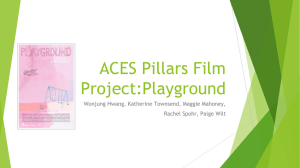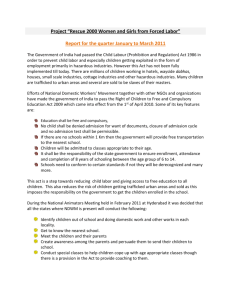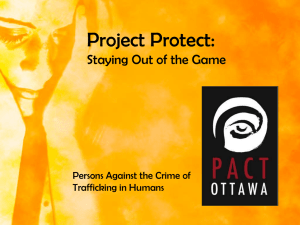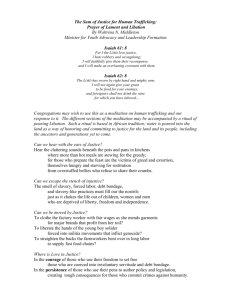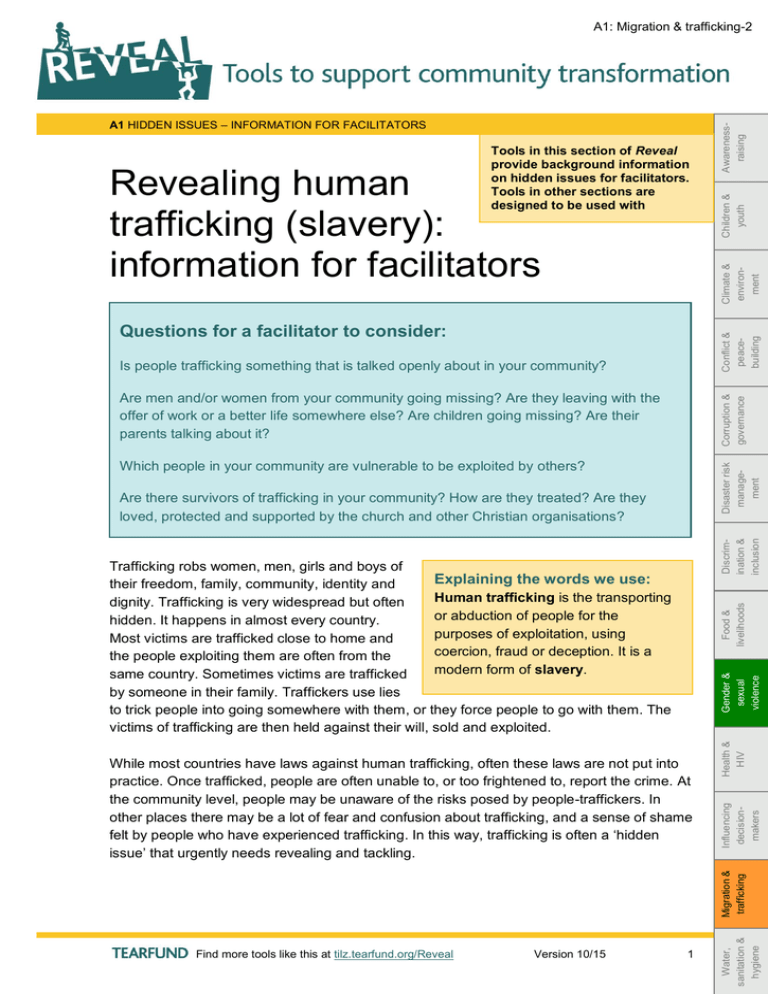
Tools in this section of Reveal
provide background information
on hidden issues for facilitators.
Tools in other sections are
designed to be used with
communities.
Climate &
environment
Revealing human
trafficking (slavery):
information for facilitators
Children &
youth
A1 HIDDEN ISSUES – INFORMATION FOR FACILITATORS
Awarenessraising
A1: Migration & trafficking-2
Conflict &
peacebuilding
Questions for a facilitator to consider:
Is people trafficking something that is talked openly about in your community?
Corruption &
governance
Are men and/or women from your community going missing? Are they leaving with the
offer of work or a better life somewhere else? Are children going missing? Are their
parents talking about it?
Disaster risk
management
Which people in your community are vulnerable to be exploited by others?
Discrimination &
inclusion
Are there survivors of trafficking in your community? How are they treated? Are they
loved, protected and supported by the church and other Christian organisations?
Find more tools like this at tilz.tearfund.org/Reveal
Version 10/15
1
Influencing
decisionmakers
Water,
sanitation &
hygiene
Migration &
trafficking
While most countries have laws against human trafficking, often these laws are not put into
practice. Once trafficked, people are often unable to, or too frightened to, report the crime. At
the community level, people may be unaware of the risks posed by people-traffickers. In
other places there may be a lot of fear and confusion about trafficking, and a sense of shame
felt by people who have experienced trafficking. In this way, trafficking is often a ‘hidden
issue’ that urgently needs revealing and tackling.
Health &
HIV
Gender &
sexual
violence
Food &
livelihoods
Trafficking robs women, men, girls and boys of
Explaining the words we use:
their freedom, family, community, identity and
Human trafficking is the transporting
dignity. Trafficking is very widespread but often
or abduction of people for the
hidden. It happens in almost every country.
purposes of exploitation, using
Most victims are trafficked close to home and
coercion, fraud or deception. It is a
the people exploiting them are often from the
modern form of slavery.
same country. Sometimes victims are trafficked
by someone in their family. Traffickers use lies
to trick people into going somewhere with them, or they force people to go with them. The
victims of trafficking are then held against their will, sold and exploited.
A1: Migration & trafficking-2
A1 HIDDEN ISSUES – REVEALING HUMAN TRAFFICKING
What does the Bible say?
Awarenessraising
Children &
youth
Climate &
environment
Conflict &
peacebuilding
The Bible is clear that all human beings have been created in God’s image with inherent
value and dignity before him (Genesis 1:27–28, 31). Every person is wonderfully and
fearfully made (Psalm 139), and greatly loved by God. Throughout the Bible we see
God’s command that the vulnerable and poor should be cared for. Abuse and
exploitation of people is a sin. Isaiah 61, quoted by Jesus at the start of his ministry (Luke
4:16-19), clearly shows God’s heart:
“The Spirit of the Sovereign LORD is on me,
because the LORD has anointed me
to proclaim good news to the poor.
He has sent me to bind up the broken-hearted,
to proclaim freedom for the captives
and release from darkness for the prisoners …”
Corruption &
governance
Christians are called to love and care for the poor and oppressed, and to challenge
injustice (Amos 5:21-24; Micah 6:8; Isaiah 58:6-10). The church is to model what good
and true community and family looks like – loving, protecting and caring for one another,
including survivors of trafficking.
Disaster risk
management
For Bible studies on this issue, please see Section B of Reveal.
Discrimination &
inclusion
Understanding trafficking
Food &
livelihoods
Gender &
sexual
violence
Victims of human trafficking do not agree to being exploited. Traffickers often tell lies to
people so that they agree to go with them, or they use force. They make the victims (and
sometimes their families) feel that they can be trusted, and then they abuse that trust.
Examples of the lies they use include offers of legitimate and legal work as waitresses, in
homes or in shops, and offers of marriage, education or a better life. Sometimes, young men
pretend to fall in love with a girl, persuade her to move away, and then hand her over to
another person along the trafficking chain. Sometimes, people are sold into trafficking by
partners, friends, neighbours or even parents. Traffickers may offer desperate parents a
large sum of money with the promise of a much better life for their children, as well as money
that will meet their immediate needs.
Health &
HIV
Influencing
decisionmakers
Migration &
trafficking
Victims are then held against their will and are exploited in horrendous ways. Traffickers
make money from their victims. They exploit people in different ways, including:
Forcing victims to work with little or no pay, for example as domestic workers, on
fishing boats, for construction companies, in factories, in agriculture or in catering
businesses.
Forcing them to work in prostitution (about half of all known cases of human
trafficking are related to sexual exploitation).
Selling their organs (body parts) for profit.
Using victims to transport illegal drugs (sometimes called ‘drug mules’).
Water,
sanitation &
hygiene
Find more tools like this at tilz.tearfund.org/Reveal
2
A1: Migration & trafficking-2
A1 HIDDEN ISSUES – REVEALING HUMAN TRAFFICKING
Awarenessraising
Trafficking fuels organised crime groups that usually participate in many other illegal
activities.
Children &
youth
Poverty makes people vulnerable to human trafficking. A lack of education and
understanding of safe migration makes it harder for people to recognise the lies which
traffickers tell. Lack of income and livelihood opportunities can cause people to try to find
work in other places. When family and community structures are weakened by disasters or
conflict, people’s vulnerability increases.
Climate &
environment
In general, more women are affected by trafficking than men. Approximately 70 per cent of
victims are women and girls; 30 per cent are men and boys (UN Office of Drugs and Crime).
Children of all ages are at risk of being trafficked.
Conflict &
peacebuilding
How are migration and people smuggling different to trafficking?
Corruption &
governance
Migration refers to the movement of people from one place to another, often with the
intention of settling in the new location. It can be from one country to another, or within
a country’s borders. Illegal migration, where people do not have legal status in the
country they move to, puts people at risk of being trafficked.
Find more tools like this at tilz.tearfund.org/Reveal
3
Gender &
sexual
violence
Health &
HIV
Influencing
decisionmakers
Migration &
trafficking
Trafficking is an extreme violation of human rights. Victims of trafficking often experience
horrific levels of abuse for very long periods of time. For example:
They may be physically beaten and tortured by their traffickers.
Their organs may be removed by unqualified people using unclean and unsafe instruments
and procedures.
They may have to work in dangerous and hazardous conditions in agriculture, factories or
construction sites, resulting in severe illness and injuries.
Many victims are forced to work in prostitution or the commercial sex trade where they
endure rape and sexual abuse and exploitation over long periods of time.
Victims may be denied adequate food, water and health care and forced to live in
inhumane conditions. Children in particular are extremely vulnerable to malnourishment
which can severely damage their growth and development.
Many victims may also suffer from substance abuse problems or addictions as a result of
being forced into drug use by their traffickers or by turning to substance abuse to help
cope with their desperate situations.
Water,
sanitation &
hygiene
How does trafficking affect people?
Food &
livelihoods
Discrimination &
inclusion
Disaster risk
management
People smuggling involves smugglers being paid, or gaining some other benefit, to
transport people into another country. Once they have arrived, they are then free to
leave the smugglers – this makes smuggling different to trafficking. However, once in
the new country, illegally without legal documents, the people who have been
smuggled are often vulnerable to exploitation. The journey itself may also pose
significant risks to the safety of the people being smuggled.
A1: Migration & trafficking-2
A1 HIDDEN ISSUES – REVEALING HUMAN TRAFFICKING
Awarenessraising
Trafficking also leads to extreme emotional stress for victims. They may experience
shame, grief, fear, distrust, suicidal thoughts and post-traumatic stress disorder.
Even if victims of trafficking are able to return to their home community, communities may
refuse to welcome back people who have been involved in prostitution – whether they
were trafficked or not. Victims then face the added trauma of stigma and rejection by their
home community.
Children &
youth
The abuse that trafficked people endure can lead to severe physical, reproductive, emotional
and mental health problems.
Climate &
environment
The impacts of trafficking go much further than harming the people being trafficked. Families
and communities are robbed of their loved ones. People leave and are never heard from
again. It is a huge injustice in our world and must be stopped.
Conflict &
peacebuilding
Corruption &
governance
Churches and communities everywhere have an important role to play in revealing the
dangers of trafficking, so that people are informed and it can be prevented. Churches
and communities also have a calling to welcome, care for and protect rescued
survivors, helping them integrate back into communities. In some places, churches
and communities may also be involved in locating and rescuing trafficked people.
Using Reveal
Disaster risk
management
Reveal includes tools to help you raise the issues involved in trafficking with communities.
You can find these in Section A2. You can find Bible studies to explore what God thinks
about this issue in Section B. And there are tools to help you address and tackle this
problem in Section C
Discrimination &
inclusion
Finding out more
Food &
livelihoods
Tearfund (2015) Footsteps 96 – Human trafficking
http://tilz.tearfund.org/en/resources/publications/footsteps/footsteps_91-100/footsteps_96/
Gender &
sexual
violence
The Born to Fly Project is a child trafficking prevention programme that educates children
and their parents about the dangers of child trafficking. All the materials can be downloaded
free of charge but you will need to register on the Born to Fly website to receive a password
to access the documents http://born2fly.org
Health &
HIV
FAAST is an alliance of Christian organizations working together to combat slavery and
human trafficking http://faastinternational.org/
Influencing
decisionmakers
Migration &
trafficking
Related tools:
A2 – Understanding vulnerability to human trafficking (slavery) [A2: Migration & trafficking-2]
A2 – The lies traffickers tell [A2: Migration & trafficking-3]
A2 – Life after human trafficking: understanding the journey of healing [A2: Migration &
trafficking-4]
B – Loving the outcast (Bible study) [B: Discrimination & inclusion-2]
B – Each of us is special to God [B: Discrimination & inclusion-5]
C2 – Protecting our communities from human trafficking [C2: Migration & trafficking-1]
Water,
sanitation &
hygiene
Find more tools like this at tilz.tearfund.org/Reveal
4


